Nursing Assignment: Risk Factors and Management for Falls and Pressure Injuries
VerifiedAdded on 2022/12/26
|7
|1860
|46
AI Summary
This nursing assignment discusses the risk factors that put Maude at risk of falls injuries and pressure injuries, as well as the nursing management plan for preventing falls and sustaining pressure injuries. It also provides information on promoting healthy bowel habits for Maude and her husband.
Contribute Materials
Your contribution can guide someone’s learning journey. Share your
documents today.

1
NURSING ASSIGNMENT
NURSING ASSIGNMENT
Name of the student
University Name
Author’s note
NURSING ASSIGNMENT
NURSING ASSIGNMENT
Name of the student
University Name
Author’s note
Secure Best Marks with AI Grader
Need help grading? Try our AI Grader for instant feedback on your assignments.
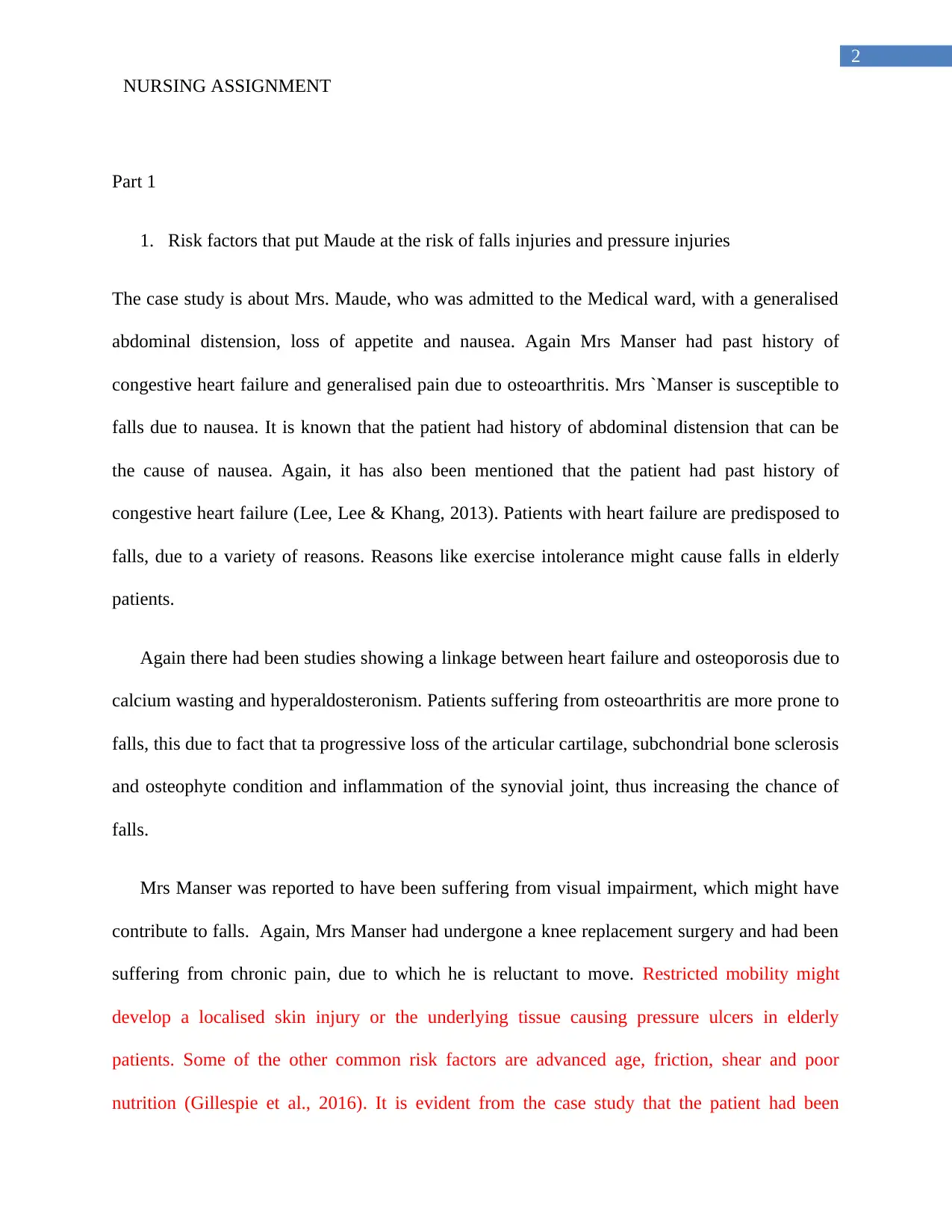
2
NURSING ASSIGNMENT
Part 1
1. Risk factors that put Maude at the risk of falls injuries and pressure injuries
The case study is about Mrs. Maude, who was admitted to the Medical ward, with a generalised
abdominal distension, loss of appetite and nausea. Again Mrs Manser had past history of
congestive heart failure and generalised pain due to osteoarthritis. Mrs `Manser is susceptible to
falls due to nausea. It is known that the patient had history of abdominal distension that can be
the cause of nausea. Again, it has also been mentioned that the patient had past history of
congestive heart failure (Lee, Lee & Khang, 2013). Patients with heart failure are predisposed to
falls, due to a variety of reasons. Reasons like exercise intolerance might cause falls in elderly
patients.
Again there had been studies showing a linkage between heart failure and osteoporosis due to
calcium wasting and hyperaldosteronism. Patients suffering from osteoarthritis are more prone to
falls, this due to fact that ta progressive loss of the articular cartilage, subchondrial bone sclerosis
and osteophyte condition and inflammation of the synovial joint, thus increasing the chance of
falls.
Mrs Manser was reported to have been suffering from visual impairment, which might have
contribute to falls. Again, Mrs Manser had undergone a knee replacement surgery and had been
suffering from chronic pain, due to which he is reluctant to move. Restricted mobility might
develop a localised skin injury or the underlying tissue causing pressure ulcers in elderly
patients. Some of the other common risk factors are advanced age, friction, shear and poor
nutrition (Gillespie et al., 2016). It is evident from the case study that the patient had been
NURSING ASSIGNMENT
Part 1
1. Risk factors that put Maude at the risk of falls injuries and pressure injuries
The case study is about Mrs. Maude, who was admitted to the Medical ward, with a generalised
abdominal distension, loss of appetite and nausea. Again Mrs Manser had past history of
congestive heart failure and generalised pain due to osteoarthritis. Mrs `Manser is susceptible to
falls due to nausea. It is known that the patient had history of abdominal distension that can be
the cause of nausea. Again, it has also been mentioned that the patient had past history of
congestive heart failure (Lee, Lee & Khang, 2013). Patients with heart failure are predisposed to
falls, due to a variety of reasons. Reasons like exercise intolerance might cause falls in elderly
patients.
Again there had been studies showing a linkage between heart failure and osteoporosis due to
calcium wasting and hyperaldosteronism. Patients suffering from osteoarthritis are more prone to
falls, this due to fact that ta progressive loss of the articular cartilage, subchondrial bone sclerosis
and osteophyte condition and inflammation of the synovial joint, thus increasing the chance of
falls.
Mrs Manser was reported to have been suffering from visual impairment, which might have
contribute to falls. Again, Mrs Manser had undergone a knee replacement surgery and had been
suffering from chronic pain, due to which he is reluctant to move. Restricted mobility might
develop a localised skin injury or the underlying tissue causing pressure ulcers in elderly
patients. Some of the other common risk factors are advanced age, friction, shear and poor
nutrition (Gillespie et al., 2016). It is evident from the case study that the patient had been
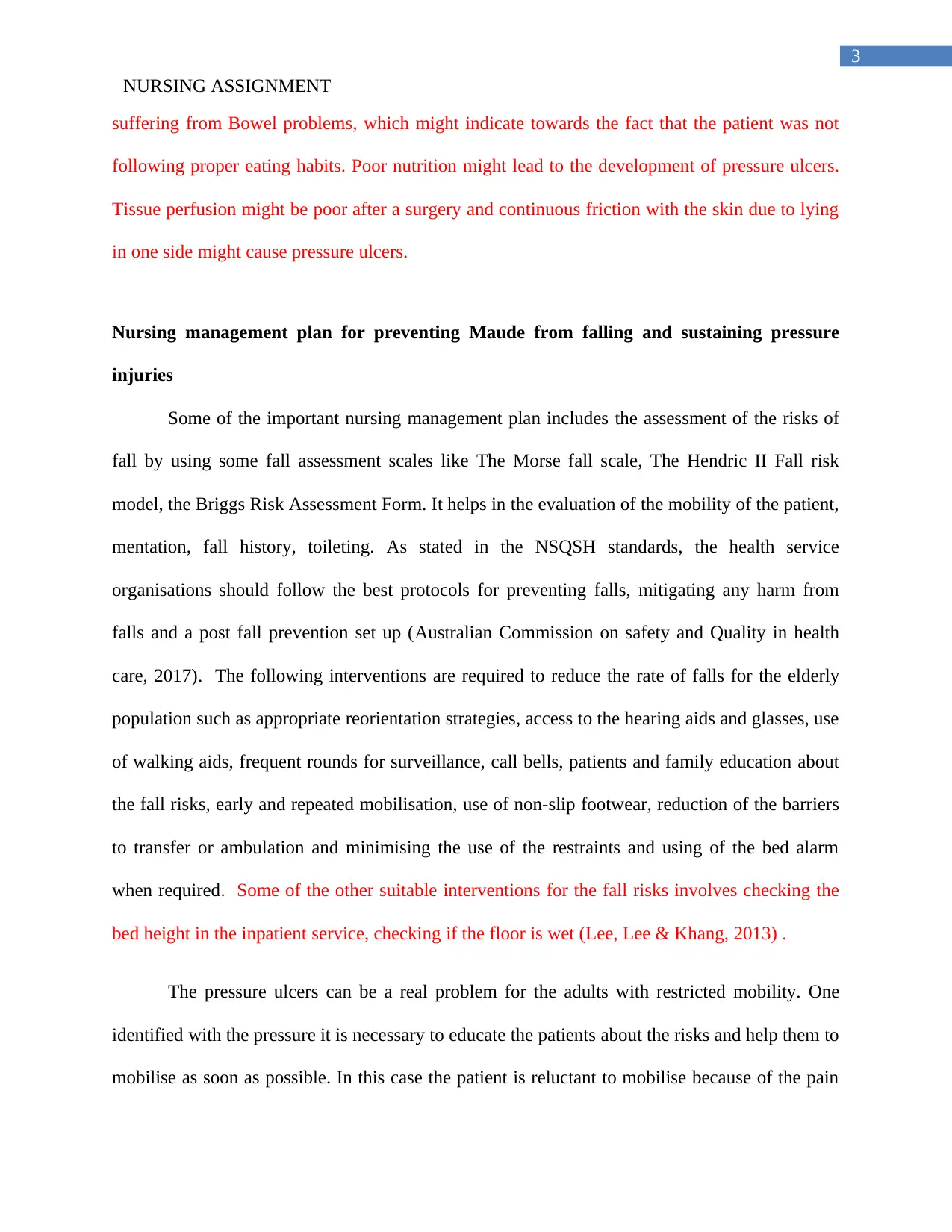
3
NURSING ASSIGNMENT
suffering from Bowel problems, which might indicate towards the fact that the patient was not
following proper eating habits. Poor nutrition might lead to the development of pressure ulcers.
Tissue perfusion might be poor after a surgery and continuous friction with the skin due to lying
in one side might cause pressure ulcers.
Nursing management plan for preventing Maude from falling and sustaining pressure
injuries
Some of the important nursing management plan includes the assessment of the risks of
fall by using some fall assessment scales like The Morse fall scale, The Hendric II Fall risk
model, the Briggs Risk Assessment Form. It helps in the evaluation of the mobility of the patient,
mentation, fall history, toileting. As stated in the NSQSH standards, the health service
organisations should follow the best protocols for preventing falls, mitigating any harm from
falls and a post fall prevention set up (Australian Commission on safety and Quality in health
care, 2017). The following interventions are required to reduce the rate of falls for the elderly
population such as appropriate reorientation strategies, access to the hearing aids and glasses, use
of walking aids, frequent rounds for surveillance, call bells, patients and family education about
the fall risks, early and repeated mobilisation, use of non-slip footwear, reduction of the barriers
to transfer or ambulation and minimising the use of the restraints and using of the bed alarm
when required. Some of the other suitable interventions for the fall risks involves checking the
bed height in the inpatient service, checking if the floor is wet (Lee, Lee & Khang, 2013) .
The pressure ulcers can be a real problem for the adults with restricted mobility. One
identified with the pressure it is necessary to educate the patients about the risks and help them to
mobilise as soon as possible. In this case the patient is reluctant to mobilise because of the pain
NURSING ASSIGNMENT
suffering from Bowel problems, which might indicate towards the fact that the patient was not
following proper eating habits. Poor nutrition might lead to the development of pressure ulcers.
Tissue perfusion might be poor after a surgery and continuous friction with the skin due to lying
in one side might cause pressure ulcers.
Nursing management plan for preventing Maude from falling and sustaining pressure
injuries
Some of the important nursing management plan includes the assessment of the risks of
fall by using some fall assessment scales like The Morse fall scale, The Hendric II Fall risk
model, the Briggs Risk Assessment Form. It helps in the evaluation of the mobility of the patient,
mentation, fall history, toileting. As stated in the NSQSH standards, the health service
organisations should follow the best protocols for preventing falls, mitigating any harm from
falls and a post fall prevention set up (Australian Commission on safety and Quality in health
care, 2017). The following interventions are required to reduce the rate of falls for the elderly
population such as appropriate reorientation strategies, access to the hearing aids and glasses, use
of walking aids, frequent rounds for surveillance, call bells, patients and family education about
the fall risks, early and repeated mobilisation, use of non-slip footwear, reduction of the barriers
to transfer or ambulation and minimising the use of the restraints and using of the bed alarm
when required. Some of the other suitable interventions for the fall risks involves checking the
bed height in the inpatient service, checking if the floor is wet (Lee, Lee & Khang, 2013) .
The pressure ulcers can be a real problem for the adults with restricted mobility. One
identified with the pressure it is necessary to educate the patients about the risks and help them to
mobilise as soon as possible. In this case the patient is reluctant to mobilise because of the pain
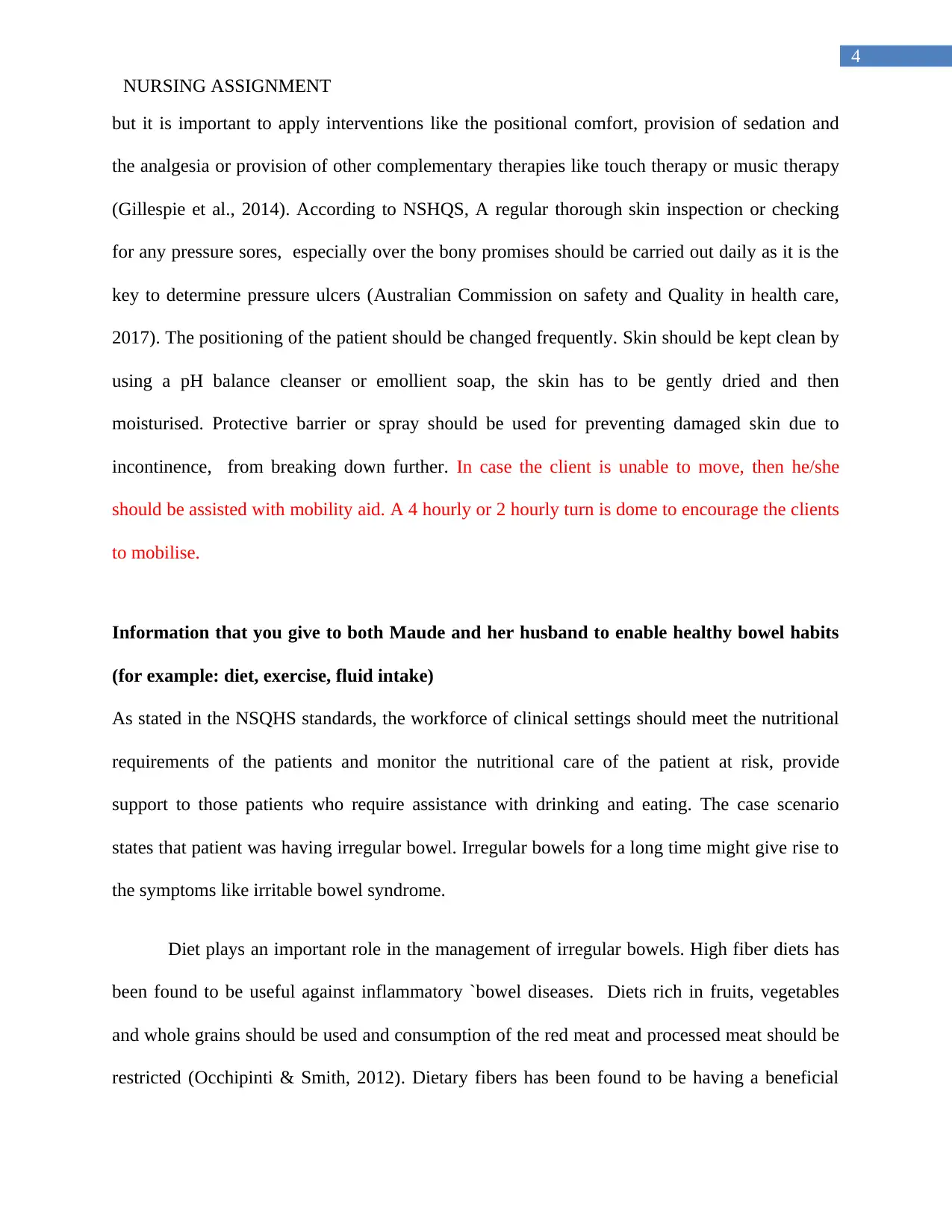
4
NURSING ASSIGNMENT
but it is important to apply interventions like the positional comfort, provision of sedation and
the analgesia or provision of other complementary therapies like touch therapy or music therapy
(Gillespie et al., 2014). According to NSHQS, A regular thorough skin inspection or checking
for any pressure sores, especially over the bony promises should be carried out daily as it is the
key to determine pressure ulcers (Australian Commission on safety and Quality in health care,
2017). The positioning of the patient should be changed frequently. Skin should be kept clean by
using a pH balance cleanser or emollient soap, the skin has to be gently dried and then
moisturised. Protective barrier or spray should be used for preventing damaged skin due to
incontinence, from breaking down further. In case the client is unable to move, then he/she
should be assisted with mobility aid. A 4 hourly or 2 hourly turn is dome to encourage the clients
to mobilise.
Information that you give to both Maude and her husband to enable healthy bowel habits
(for example: diet, exercise, fluid intake)
As stated in the NSQHS standards, the workforce of clinical settings should meet the nutritional
requirements of the patients and monitor the nutritional care of the patient at risk, provide
support to those patients who require assistance with drinking and eating. The case scenario
states that patient was having irregular bowel. Irregular bowels for a long time might give rise to
the symptoms like irritable bowel syndrome.
Diet plays an important role in the management of irregular bowels. High fiber diets has
been found to be useful against inflammatory `bowel diseases. Diets rich in fruits, vegetables
and whole grains should be used and consumption of the red meat and processed meat should be
restricted (Occhipinti & Smith, 2012). Dietary fibers has been found to be having a beneficial
NURSING ASSIGNMENT
but it is important to apply interventions like the positional comfort, provision of sedation and
the analgesia or provision of other complementary therapies like touch therapy or music therapy
(Gillespie et al., 2014). According to NSHQS, A regular thorough skin inspection or checking
for any pressure sores, especially over the bony promises should be carried out daily as it is the
key to determine pressure ulcers (Australian Commission on safety and Quality in health care,
2017). The positioning of the patient should be changed frequently. Skin should be kept clean by
using a pH balance cleanser or emollient soap, the skin has to be gently dried and then
moisturised. Protective barrier or spray should be used for preventing damaged skin due to
incontinence, from breaking down further. In case the client is unable to move, then he/she
should be assisted with mobility aid. A 4 hourly or 2 hourly turn is dome to encourage the clients
to mobilise.
Information that you give to both Maude and her husband to enable healthy bowel habits
(for example: diet, exercise, fluid intake)
As stated in the NSQHS standards, the workforce of clinical settings should meet the nutritional
requirements of the patients and monitor the nutritional care of the patient at risk, provide
support to those patients who require assistance with drinking and eating. The case scenario
states that patient was having irregular bowel. Irregular bowels for a long time might give rise to
the symptoms like irritable bowel syndrome.
Diet plays an important role in the management of irregular bowels. High fiber diets has
been found to be useful against inflammatory `bowel diseases. Diets rich in fruits, vegetables
and whole grains should be used and consumption of the red meat and processed meat should be
restricted (Occhipinti & Smith, 2012). Dietary fibers has been found to be having a beneficial
Secure Best Marks with AI Grader
Need help grading? Try our AI Grader for instant feedback on your assignments.
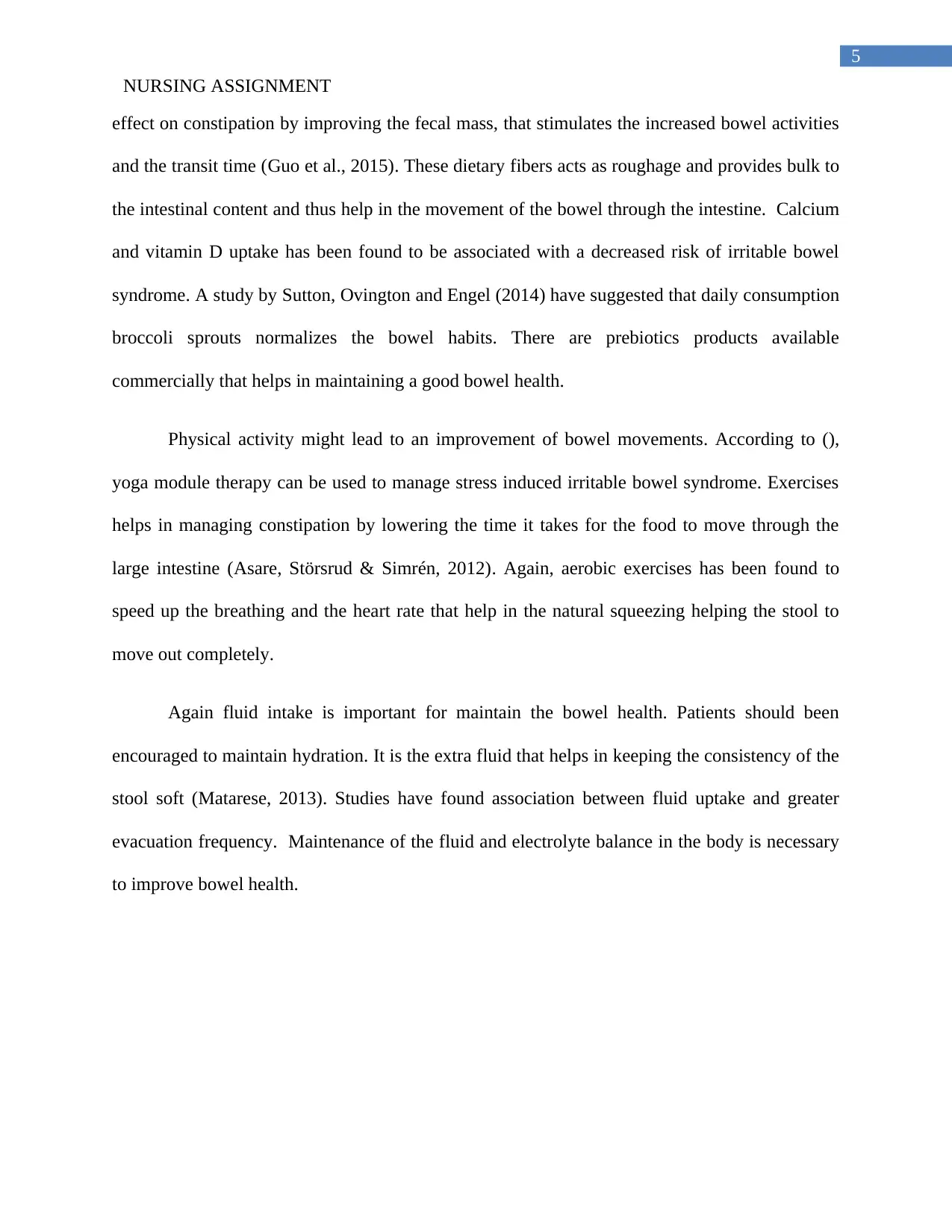
5
NURSING ASSIGNMENT
effect on constipation by improving the fecal mass, that stimulates the increased bowel activities
and the transit time (Guo et al., 2015). These dietary fibers acts as roughage and provides bulk to
the intestinal content and thus help in the movement of the bowel through the intestine. Calcium
and vitamin D uptake has been found to be associated with a decreased risk of irritable bowel
syndrome. A study by Sutton, Ovington and Engel (2014) have suggested that daily consumption
broccoli sprouts normalizes the bowel habits. There are prebiotics products available
commercially that helps in maintaining a good bowel health.
Physical activity might lead to an improvement of bowel movements. According to (),
yoga module therapy can be used to manage stress induced irritable bowel syndrome. Exercises
helps in managing constipation by lowering the time it takes for the food to move through the
large intestine (Asare, Störsrud & Simrén, 2012). Again, aerobic exercises has been found to
speed up the breathing and the heart rate that help in the natural squeezing helping the stool to
move out completely.
Again fluid intake is important for maintain the bowel health. Patients should been
encouraged to maintain hydration. It is the extra fluid that helps in keeping the consistency of the
stool soft (Matarese, 2013). Studies have found association between fluid uptake and greater
evacuation frequency. Maintenance of the fluid and electrolyte balance in the body is necessary
to improve bowel health.
NURSING ASSIGNMENT
effect on constipation by improving the fecal mass, that stimulates the increased bowel activities
and the transit time (Guo et al., 2015). These dietary fibers acts as roughage and provides bulk to
the intestinal content and thus help in the movement of the bowel through the intestine. Calcium
and vitamin D uptake has been found to be associated with a decreased risk of irritable bowel
syndrome. A study by Sutton, Ovington and Engel (2014) have suggested that daily consumption
broccoli sprouts normalizes the bowel habits. There are prebiotics products available
commercially that helps in maintaining a good bowel health.
Physical activity might lead to an improvement of bowel movements. According to (),
yoga module therapy can be used to manage stress induced irritable bowel syndrome. Exercises
helps in managing constipation by lowering the time it takes for the food to move through the
large intestine (Asare, Störsrud & Simrén, 2012). Again, aerobic exercises has been found to
speed up the breathing and the heart rate that help in the natural squeezing helping the stool to
move out completely.
Again fluid intake is important for maintain the bowel health. Patients should been
encouraged to maintain hydration. It is the extra fluid that helps in keeping the consistency of the
stool soft (Matarese, 2013). Studies have found association between fluid uptake and greater
evacuation frequency. Maintenance of the fluid and electrolyte balance in the body is necessary
to improve bowel health.

6
NURSING ASSIGNMENT
References
Asare, F., Störsrud, S., & Simrén, M. (2012). Meditation over medication for irritable bowel
syndrome? On exercise and alternative treatments for irritable bowel syndrome. Current
gastroenterology reports, 14(4), 283-289.
Australian Commission on safety and Quality in health care, (2017).National Safety and Quality
Health Service Standards. Access date: 2.5.2019.Retrieved from:
https://www.safetyandquality.gov.au/wp-content/uploads/2017/12/National-Safety-and-
Quality-Health-Service-Standards-second-edition.pdf
Boilesen, S. N., Tahan, S., Dias, F. C., Melli, L. C. F. L., & de Morais, M. B. (2017). Water and
fluid intake in the prevention and treatment of functional constipation in children and
adolescents: is there evidence?. Jornal de Pediatria (Versão em Português), 93(4), 320-
327.
Chey, W. D., Kurlander, J., & Eswaran, S. (2015). Irritable bowel syndrome: a clinical review.
Jama, 313(9), 949-958.
Gillespie, B. M., Chaboyer, W. P., McInnes, E., Kent, B., Whitty, J. A., & Thalib, L. (2014).
Repositioning for pressure ulcer prevention in adults. Cochrane Database of Systematic
Reviews, (4).
Guo, Y. B., Zhuang, K. M., Kuang, L., Zhan, Q., Wang, X. F., & Liu, S. D. (2015). Association
between diet and lifestyle habits and irritable bowel syndrome: a case-control study. Gut
and liver, 9(5), 649.
NURSING ASSIGNMENT
References
Asare, F., Störsrud, S., & Simrén, M. (2012). Meditation over medication for irritable bowel
syndrome? On exercise and alternative treatments for irritable bowel syndrome. Current
gastroenterology reports, 14(4), 283-289.
Australian Commission on safety and Quality in health care, (2017).National Safety and Quality
Health Service Standards. Access date: 2.5.2019.Retrieved from:
https://www.safetyandquality.gov.au/wp-content/uploads/2017/12/National-Safety-and-
Quality-Health-Service-Standards-second-edition.pdf
Boilesen, S. N., Tahan, S., Dias, F. C., Melli, L. C. F. L., & de Morais, M. B. (2017). Water and
fluid intake in the prevention and treatment of functional constipation in children and
adolescents: is there evidence?. Jornal de Pediatria (Versão em Português), 93(4), 320-
327.
Chey, W. D., Kurlander, J., & Eswaran, S. (2015). Irritable bowel syndrome: a clinical review.
Jama, 313(9), 949-958.
Gillespie, B. M., Chaboyer, W. P., McInnes, E., Kent, B., Whitty, J. A., & Thalib, L. (2014).
Repositioning for pressure ulcer prevention in adults. Cochrane Database of Systematic
Reviews, (4).
Guo, Y. B., Zhuang, K. M., Kuang, L., Zhan, Q., Wang, X. F., & Liu, S. D. (2015). Association
between diet and lifestyle habits and irritable bowel syndrome: a case-control study. Gut
and liver, 9(5), 649.
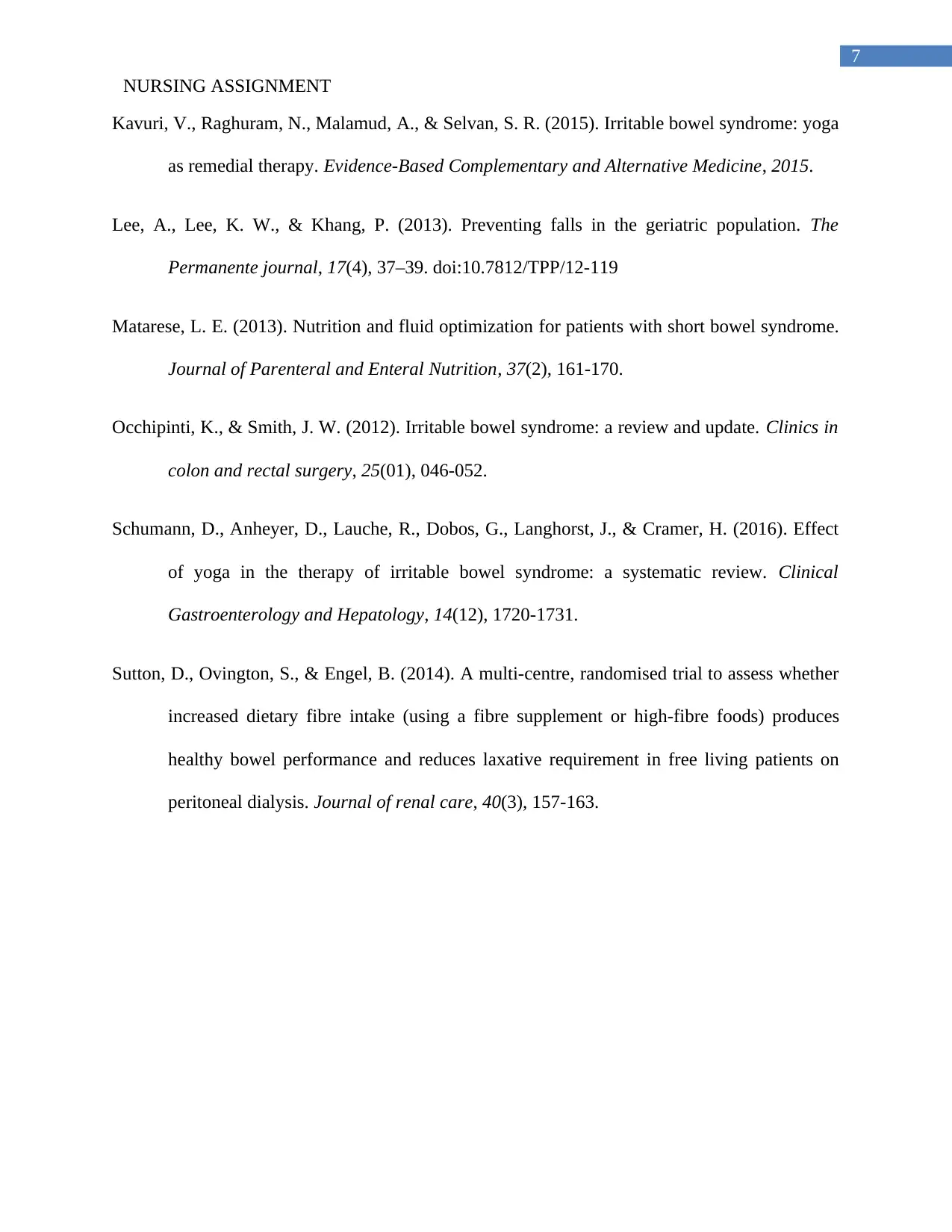
7
NURSING ASSIGNMENT
Kavuri, V., Raghuram, N., Malamud, A., & Selvan, S. R. (2015). Irritable bowel syndrome: yoga
as remedial therapy. Evidence-Based Complementary and Alternative Medicine, 2015.
Lee, A., Lee, K. W., & Khang, P. (2013). Preventing falls in the geriatric population. The
Permanente journal, 17(4), 37–39. doi:10.7812/TPP/12-119
Matarese, L. E. (2013). Nutrition and fluid optimization for patients with short bowel syndrome.
Journal of Parenteral and Enteral Nutrition, 37(2), 161-170.
Occhipinti, K., & Smith, J. W. (2012). Irritable bowel syndrome: a review and update. Clinics in
colon and rectal surgery, 25(01), 046-052.
Schumann, D., Anheyer, D., Lauche, R., Dobos, G., Langhorst, J., & Cramer, H. (2016). Effect
of yoga in the therapy of irritable bowel syndrome: a systematic review. Clinical
Gastroenterology and Hepatology, 14(12), 1720-1731.
Sutton, D., Ovington, S., & Engel, B. (2014). A multi‐centre, randomised trial to assess whether
increased dietary fibre intake (using a fibre supplement or high‐fibre foods) produces
healthy bowel performance and reduces laxative requirement in free living patients on
peritoneal dialysis. Journal of renal care, 40(3), 157-163.
NURSING ASSIGNMENT
Kavuri, V., Raghuram, N., Malamud, A., & Selvan, S. R. (2015). Irritable bowel syndrome: yoga
as remedial therapy. Evidence-Based Complementary and Alternative Medicine, 2015.
Lee, A., Lee, K. W., & Khang, P. (2013). Preventing falls in the geriatric population. The
Permanente journal, 17(4), 37–39. doi:10.7812/TPP/12-119
Matarese, L. E. (2013). Nutrition and fluid optimization for patients with short bowel syndrome.
Journal of Parenteral and Enteral Nutrition, 37(2), 161-170.
Occhipinti, K., & Smith, J. W. (2012). Irritable bowel syndrome: a review and update. Clinics in
colon and rectal surgery, 25(01), 046-052.
Schumann, D., Anheyer, D., Lauche, R., Dobos, G., Langhorst, J., & Cramer, H. (2016). Effect
of yoga in the therapy of irritable bowel syndrome: a systematic review. Clinical
Gastroenterology and Hepatology, 14(12), 1720-1731.
Sutton, D., Ovington, S., & Engel, B. (2014). A multi‐centre, randomised trial to assess whether
increased dietary fibre intake (using a fibre supplement or high‐fibre foods) produces
healthy bowel performance and reduces laxative requirement in free living patients on
peritoneal dialysis. Journal of renal care, 40(3), 157-163.
1 out of 7
Related Documents
Your All-in-One AI-Powered Toolkit for Academic Success.
+13062052269
info@desklib.com
Available 24*7 on WhatsApp / Email
![[object Object]](/_next/static/media/star-bottom.7253800d.svg)
Unlock your academic potential
© 2024 | Zucol Services PVT LTD | All rights reserved.




